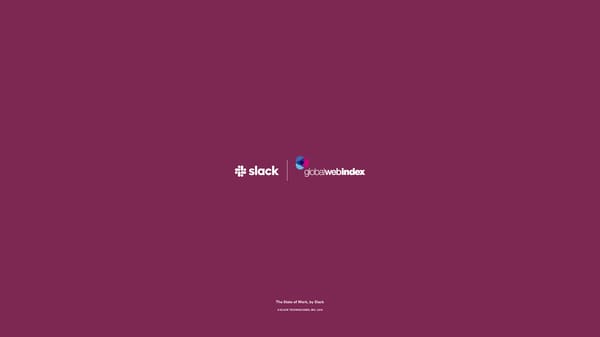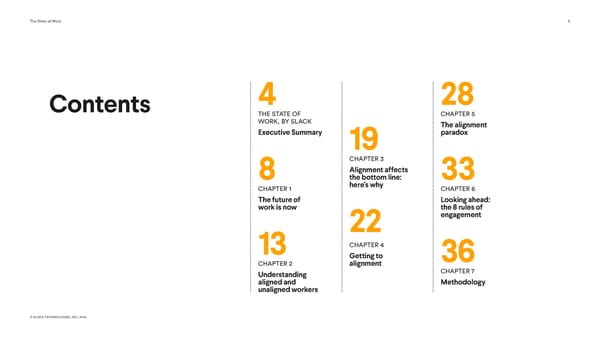Slack State of Work
A highlight of the benefits of an aligned workforce and how to achieve it
The State of Work 1 The State of Work slack.com/state-of-work © SLACK TECHNOLOGIES, INC. 2019
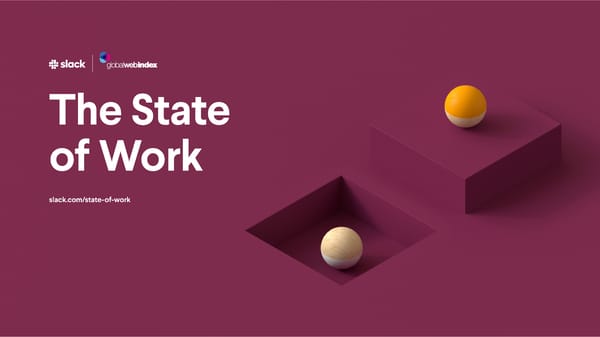
This is a modal window.
The State of Work 2 Modern work is more complex and interdependent than ever before. A new study by Slack and market research firm GlobalWebIndex explores what it takes to thrive in this new era of business. © SLACK TECHNOLOGIES, INC. 2019
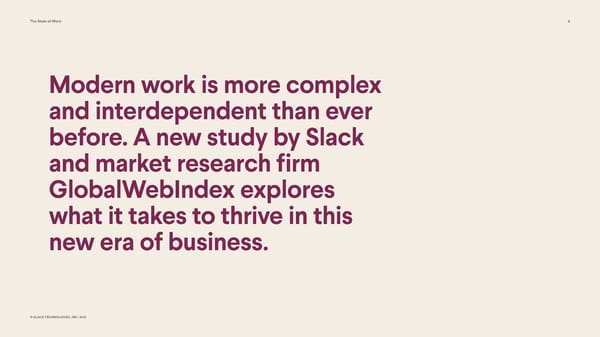
The State of Work 3 Contents 4 28 THE STATE OF CHAPTER 5 WORK, BY SLACK The alignment Executive Summary 19 paradox CHAPTER 3 Alignment affects 8 the bottom line: 33 CHAPTER 1 here’s why CHAPTER 6 The future of Looking ahead: work is now the 8 rules of 22 engagement 13 CHAPTER 4 Getting to 36 CHAPTER 2 alignment Understanding CHAPTER 7 aligned and Methodology unaligned workers © SLACK TECHNOLOGIES, INC. 2019
The State of Work 44 The State of Work, by Slack Executive Summary slack.com/state-of-work ©© S SLLAACCKK T TEECCHHNNOOLLOOGGIESIES,, IN INCC.. 22001199
The State of Work Executive Summary 5 If going by This is certainly true in many ways. So when we set out to better understand The pace of change is faster than at any the state of work today, we were eager to headlines other time in history, and no industry explore first-person attitudes and experi- has yet escaped the forces of what ences. How do these core beliefs about is often called the “Fourth Industrial work affect worker engagement and alone, the state Revolution.” But it’s a surprisingly organizational success? What we learned of work today incomplete picture. is revealed in this analysis. If anything, the true state of work is Slack’s State of Work report draws from is defined by more people-powered than ever before. 17,000 knowledge workers, up and down the organizational chart, from CEOs to Simply put, as automation rises, the work frontline employees, ages 16 to 64. They transformative that is left requires a decidedly human live in 10 countries, span more than 40 touch, such as complex problem-solving industries, and work for companies of technology. and collaboration. all stages and sizes, from “micro-emerg- ing” businesses to large, well-established We see it every day at Slack, even enterprises. There are startups less than as we build this very technology. a year old and companies in business for We believe that any analysis of trends and more than 50 years. To contextualize the technology is secondary to the human data, we conducted in-depth interviews experience of those trends and technolo- with economists, workplace psycholo- gy. (Yes, this from a software company.) gists and frontline workers themselves. © SLACK TECHNOLOGIES, INC. 2019
The State of Work Executive Summary 6 HERE’S WHAT WE FOUND: People crave Without insight into connection to their that organizational organization’s vision, people struggle strategic vision. in the workplace. Understanding the big picture is no longer solely While most people want to feel more engaged, the domain of the C-suite. We found a direct there is a subset who feel disconnected from correlation between monthly communication their company’s strategy, vision and set of of company strategy (the most frequent option operating principles. These “unaligned” workers available on the survey) and people rating their are likelier than their more “aligned” counterparts companies as “excellent” against a long list of to have never heard their company discuss attributes: career progression; collaboration; strategic goals. They focus less on innovation communication; effective use of technology; and are less likely to collaborate outside of their productivity; morale; training; work-life balance; immediate teams. They are also significantly culture; and openness to feedback. more likely to report low morale. © SLACK TECHNOLOGIES, INC. 2019
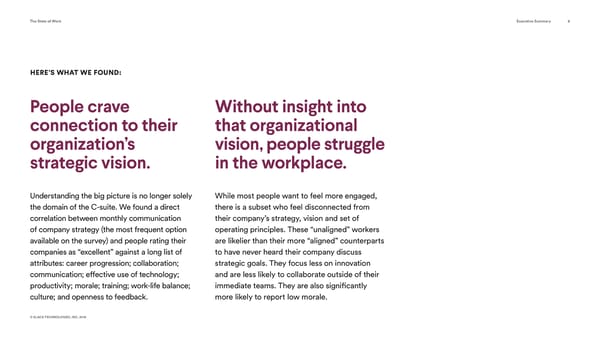
The State of Work Executive Summary 7 Given that connection and communication can Throughout the data, aligned workers show greater transparency, clearer documentation of shape each knowledge worker’s experience, we a stronger sense of optimistic purpose, while responsibilities, more cross-team collaboration, were interested to view the data through the lens unaligned workers seem adrift. When thinking and open access to leadership. of aligned vs. unaligned. So first, our definitions: about their company’s future revenue and workforce, unaligned workers are far likelier to There are many other actionable insights from the • An aligned worker is one who agreed with this predict significant decline, while aligned workers data, which we discuss in depth throughout this statement: “I feel aligned with my company’s are more likely to forecast growth. There are analysis and summarize in Chapter 6: “Looking vision, values and operating principles.” clear benefits, then, to developing and retaining ahead: The 8 Rules of Engagement.” an aligned workforce. • An unaligned worker is one who disagreed So while roles and responsibilities will continue with the statement “I feel aligned with my The good news is that alignment is not a finite, to shift in this new era of work, our data shows company’s vision, values and operating or even scarce, resource. It’s available to all that many people are ready to confront these principles.” people and organizations. By focusing on challenges. But they need organizational support, things like effective, frequent and context-rich clear communication, effective tools, and a • A knowledge worker is anyone who holds communication, organizations can facilitate strategic vision to follow. In other words, in a an office position and/or works with data, alignment. When asked what would make them world of increasing automation and complexity, analyzes information or thinks creatively in feel more aligned, no one shot for the moon. a human-first approach can still be the most a typical workweek. They ranked, in order, surprisingly basic needs: strategic of all. © SLACK TECHNOLOGIES, INC. 2019
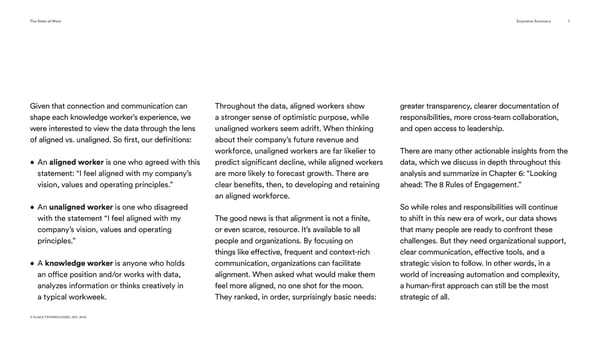
The State of Work 8 CHAPTER 1 The future of work is now © SLACK TECHNOLOGIES, INC. 2019
The State of Work The future of work is now 99 SAADIA ZAHIDI, AN Analytical Complex Innovation ECONOMIST AT THE thinking problem-solving WORLD ECONOMIC hat is transforma- Industrial Revolution), mass FORUM, SAYS THESE tive technology, production (Second Industrial SEVEN SKILLS WILL Wand how is it Revolution) and digitization BE IN DEMAND changing the way we work? (Third Industrial Revolution). Saadia Zahidi, the manag- ing director and head of the The skills of the future Centre for the New Economy e and Society at the World For knowledge workers, the Collaboration Active learning Economic Forum, describes skills required to succeed r the current era of work as have already shifted dramat- “a coming-together of dig- ically and will continue to u ital, physical and biological change. According to Zahidi, systems leading to the rise of the core tasks needed to s t Technology machine learning; the appli- perform the average job will l and design cability of technology across change by 42% over the next l u many different fields; and the three years. By 2022, that i creation of wholly new fields, is, nearly half of the average markets and sectors.” worker’s day-to-day duties will k look profoundly different. Zahidi has studied these e f forces within large multi- Demand will grow for skills national companies across such as analytical thinking, h Creativity developed and developing innovation, active learning, economies. She contends that creativity, analytical thinking, e s the current era has unfolded collaboration and complex exponentially faster than the problem-solving, while rote h f t previous three industrial rev- skills and easily repeat- olutions, which were defined able tasks will be shunted by mechanization (First off to automation. T o © SLACK TECHNOLOGIES, INC. 2019
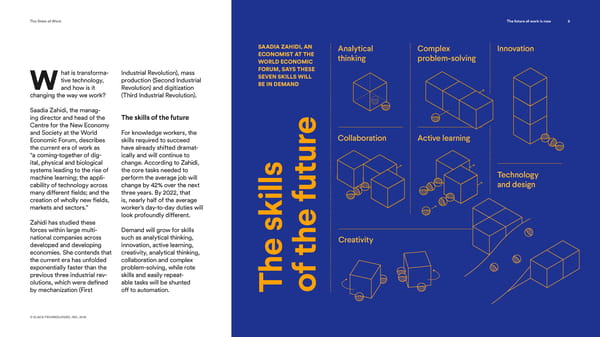
The State of Work The future of work is now 10 “It is about being able to Alignment is “table stakes” WHEN WORKERS WHEN WORKERS work and relate with your in today’s complex world UNDERSTAND DON’T UNDERSTAND THEIR COMPANY’S THEIR COMPANY’S Knowledge workers realize STRATEGY: STRATEGY: teams in a different way. that they can’t accomplish these new tasks in a vacuum or simply by adding hours to 84% 22% It is about building an their workday. To be effec- tive, they need more visibility Feel aligned with their Feel aligned with their inclusive workplace culture. into the strategic objectives company’s vision, values company’s vision, values of the business. They need a and operating principles and operating principles line of sight to the company’s It is about active listening North Star. When knowledge workers 88% 33% and more flat team understand their company’s overall strategy, they’re much Know how their day-to- Know how their day-to-day structures.” more likely to know how their day work contributes to work contributes to their work fits into the broader their company’s strategy company’s strategy picture and to feel aligned Saadia Zahidi, with their company’s direction. Managing Director Which is why it becomes so and Head of the important for organizations to transition to alignment. That is, The modern era of work, she Centre for the understand why workers find the onus isn’t all on the worker. says, “is about being able to New Economy and themselves disconnected from Much of it is on the organiza- work and relate with your Society at the World the wider corporate vision. tion to understand and invest teams in a different way. It is Economic Forum in its people and to help them about building an inclusive The data underscores the develop the skills to thrive in workplace culture. It is about need for organizations to this new era of work, accord- active listening and more flat help workers complete the ing to Zahidi. team structures.” © SLACK TECHNOLOGIES, INC. 2019
The State of Work The future of work is now 11 Are you aligned? Divergent Aligned workers Unaligned workers workplace experiences who agree who agree Building the inclusive cul- ture Zahidi describes can be a daunting task. It’s hard I feel empowered Being able to adapt At my company, I understand what I to know where to start. Alignment offers a useful lens to make strategic quickly is critical to my we have the tools need to do in my role for determining which strat- decisions or to company’s long-term and systems in place to be successful egies and tools will serve an pursue new business success to adapt quickly to organization and which will undercut its efforts. opportunities industry changes Unaligned and aligned work- ers experience the workplace in profoundly different ways—and their experiences 75% 22% 83% 40% 76% 19% 90% 43% impact their organizations. By opting for strategies that promote alignment, compa- nies benefit from a cascade of other effects, including more engaged and empow- ered workers. The opposite is also true. Strategies that derail alignment tend to cor- relate with demotivated, disengaged workers. © SLACK TECHNOLOGIES, INC. 2019
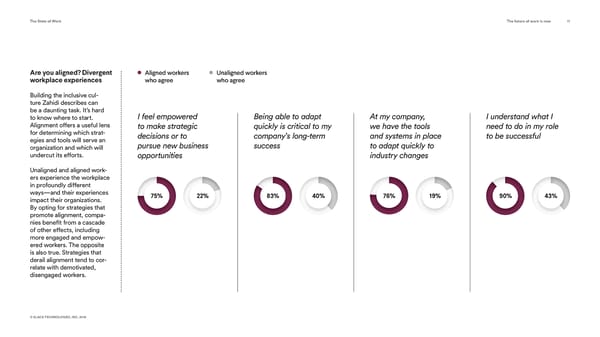
The State of Work The future of work is now 12 Management and culture TOP MANAGEMENT AND developing a positive culture, What can be done to improve Workers who challenges in the workplace CULTURE CHALLENGES boosting morale, and retain- collaboration? For starters, understand the GLOBALLY ing and aligning people is a a clear understanding of the company strategy are So what are organizations global concern. company strategy correlates more likely to rate their up against in the drive to closely with positive scores companies highly for align, upskill and empower for collaboration. Workers their people? For starters, Building a good The state of collaboration who understand their com- collaboration. workplace culture is a chief culture/working pany’s strategy are twice as concern for knowledge 1 environment Overall, knowledge work- likely to indicate that collab- RATES COLLABORATION workers worldwide; it was ers feel positive about the oration at their companies is “GOOD” OR “EXCELLENT” the most frequently cited state of collaboration at their “good” or “excellent.” “management and culture” workplaces, with two-thirds challenge globally and topped Morale/ of respondents reporting Zahidi says setting objectives the country-specific list for retaining staff that collaboration is “good” and communicating them France and India. 2 or “excellent.” Only 7% rated frequently is critical for col- 75% their companies as “poor” laboration. “It’s very hard to Company morale is another or “very poor.” But that 7% set these medium- to long- key challenge, particularly when extrapolated across term objectives around which in Australia, Singapore, Vision/leadership all knowledge workers in people can coalesce in a Understands Spain, the U.K. and the U.S. within the the 10 surveyed countries constantly shifting business company strategy Japanese workers were most 3company amounts to an estimated environment,” she says. “But concerned about building 25.6 million people. it’s through the creation of alignment between teams, those very, very clear objec- whereas those in Germany Again, the divide between tives that you get the right kind cited bureaucracy as the Alignment aligned and unaligned workers of collaboration incentives.” 37% No. 1 challenge. between teams stood out. Unaligned work- at the company ers were nearly nine times While each country has 4 as likely to rate collaboration its own set of nuanced at their companies as “poor” Doesn’t understand challenges, it’s clear that or “very poor.” company strategy © SLACK TECHNOLOGIES, INC. 2019
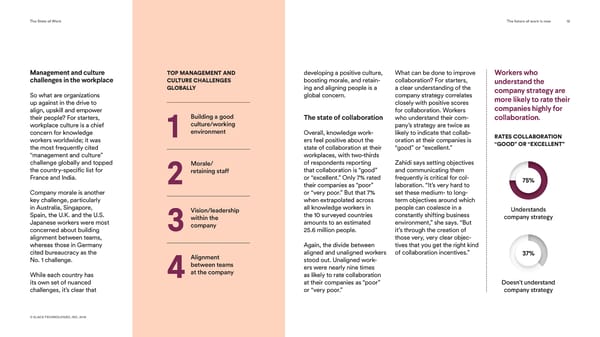
The State of Work 13 CHAPTER 2 Understanding aligned and unaligned workers © SLACK TECHNOLOGIES, INC. 2019
The State of Work Understanding aligned and unaligned workers 14 ligned and unaligned Most workers fall in the While only 11% feel some level workers exist in com- middle of the alignment of unalignment, it’s worth Apanies large and small, spectrum noting that across all 10 sur- in every industry, all over the veyed markets they amount world. They span generations to an estimated 38.5 million and workplace hierarchies. workers. Moreover, given the importance of connec- Understanding how the tivity and collaboration in aligned/unaligned chips the modern workplace, mov- fall across different cate- ing these unaligned workers gories—be it industry, age % into alignment can have a or geography—merits a of positive ripple effect through- deeper look. w out an organization. 3% 8% 23% 38% 29% or k e r For the purposes of this study, Understanding the s we looked more broadly at alignment spectrum aligned and unaligned workers and included the “somewhats” Alignment exists along a con- in their respective categories. tinuum, and most knowledge Their insights hint at what workers (69%) fall some- employers can do to tip them where in the middle. Those more fully into the “strongly in this swing group (“some- aligned” category. what aligned,” “somewhat unaligned” and “agnostic”) Strongly Somewhat Neither aligned Somewhat Strongly don’t feel strongly aligned unaligned unaligned nor unaligned aligned aligned or unaligned. Companies (agnostic) stand to gain clear benefits by converting them to fully aligned employees. alignment spectrum © SLACK TECHNOLOGIES, INC. 2019
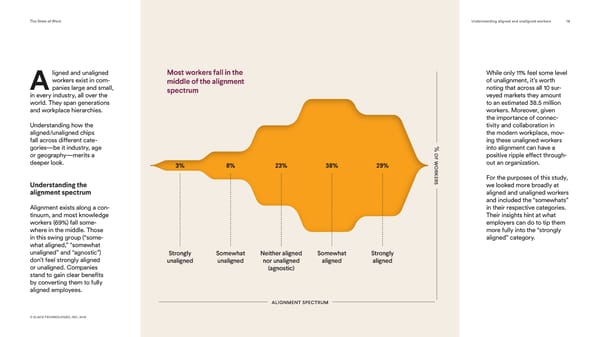
Ch2 - Industry The State of Work Understanding aligned and unaligned workers 1515 The unaligned/aligned divide cuts across all industries Aligned workers Unaligned workers Industry Aligned and unaligned work- 85% 83% 81% 85% ers are not confined to any 15% 17% 19% 15% one industry. The divide cuts across all sectors, though some trends emerge. The most aligned sectors are Arts, Media & Advertising Education & Research Environment & Resources Financial Services technology and communica- tion; manufacturing, industry and logistics; and manage- ment training. The sectors with the highest percentage of unaligned workers include 81% 79% 85% 89% health care; nonprofit; gov- 19% 21% 15% 11% ernment; and environment and resources. Age Government Health Care Legal, Law Enforcement, Management Training Military Alignment varies little across generations, though the data suggests that it increases 89% 80% 88% 90% slightly with age. The young- est cohort (16 to 24 years old) 11% 20% 12% 10% has the lowest percentage of aligned workers and the high- est percentage of unaligned workers. Older workers, those Manufacturing, Industry Nonprofit Retail, Leisure & Technology & & Logistics Hospitality Communications © SLACK TECHNOLOGIES, INC. 2019
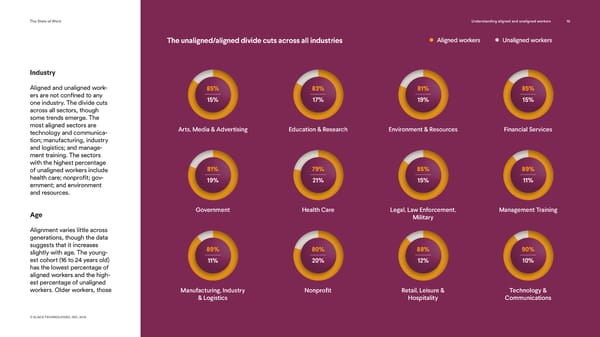
The State of Work Understanding aligned and unaligned workers 16 ages 55 to 64, were the most Generations BUSINESS SIZE (NO. OF EMPLOYEES) likely to feel aligned and the more together least likely to feel unaligned. than apart 85% Micro-emerging small business (1-20) KEY DEFINITIONS 15% 85% Company size Aligned workers 15% KNOWLEDGE WORKERS: Unaligned workers Employed individuals Aligned and unaligned work- 16 to 24 who hold an office position ers span all company sizes, Emerging small business (21-250) and/or work with data, but there is a clear sweet spot analyze information or for alignment in mid-mar- 86% think creatively in a typical ket (251–1,000 employees) 14% workweek and enterprise organizations (1,001–7,500 employees), 87% 87% where aligned workers out- 13% 13% Mid-market (251-1,000) ALIGNED WORKERS: number unaligned workers. 89% Survey respondents who agreed with the statement At the extreme ends of the 11% “I feel aligned with my company-size spectrum, 25 to 34 35 to 44 company’s vision, values unalignment is at its high- and operating principles” est. Micro-emerging small Enterprise (1,001-7,500) businesses (1–20 employ- 89% ees) over-index on unaligned UNALIGNED WORKERS: workers, as do large enter- 87% 88% 11% Survey respondents prises with more than who disagreed with the 7,500 employees. 13% 12% statement “I feel aligned Large enterprise (7,501+) with my company’s vision, 86% values and operating principles” 45 to 54 55 to 64 14% © SLACK TECHNOLOGIES, INC. 2019
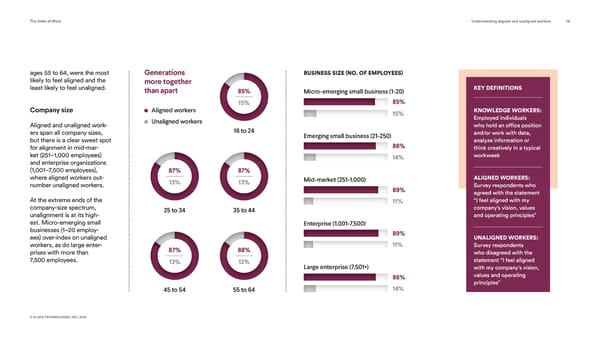
The State of Work Understanding aligned and unaligned workers 1717 Aligned workers understand how their 90% work connects with the • Have a clear company’s strategy understanding of their personal goals and objectives • Understand what they need to do in their roles to be successful 88% Have a clear understanding of how their day-to-day work contributes to their Who are the Aligned workers also rate their company’s strategy aligned workers? companies highly on key driv- ers of success. They are twice As their designation suggests, as likely as unaligned workers aligned workers have a clear to rate communication, work- understanding of their com- place culture, collaboration 86% pany’s strategy, their own and productivity as “good” Have a clear personal goals and how those or “excellent.” understanding of two things connect. Ninety their company’s percent of them know what Aligned workers are highly strategy they need to do in their roles engaged: They attend more to be successful. meetings, receive more © SLACK TECHNOLOGIES, INC. 2019
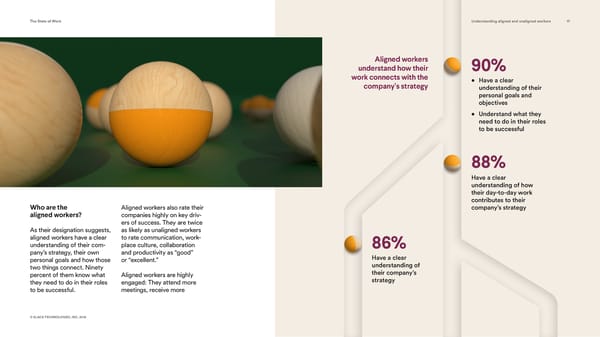
TThhe Se Sttaatte oe of Wf Woorrkk Understanding aligned and unaligned workers 1818 Aligned workers are more likely to rate their Aligned workers Unaligned workers companies highly across a wide range of factors 77% 80% 83% 81% 37% 35% 40% 37% Collaboration Communication Productivity Overall Workplace Culture communications and use Who are the as aligned workers to rate structure. More than half feel adaptation is critical to their company is open to new ideas. more software tools than their unaligned workers? “employee morale/satisfac- that their company does not company’s long-term success. And they are slightly more unaligned counterparts. They tion” as “very poor.” have the tools, systems or likely to have a consistent day- are hyperconnected to their Unaligned workers have lost structures in place to adapt to For unaligned workers, routine to-day routine and work with colleagues and want more sight of their company’s vision The majority of unaligned industry changes. In fact, they seems to rule the day. They are the same colleagues. information, rather than less, and struggle with poor morale. workers say that their com- are half as likely as aligned much less likely than aligned when making decisions. They are 12 times as likely pany has a hierarchical workers to believe that quick workers to feel that their © SLACK TECHNOLOGIES, INC. 2019
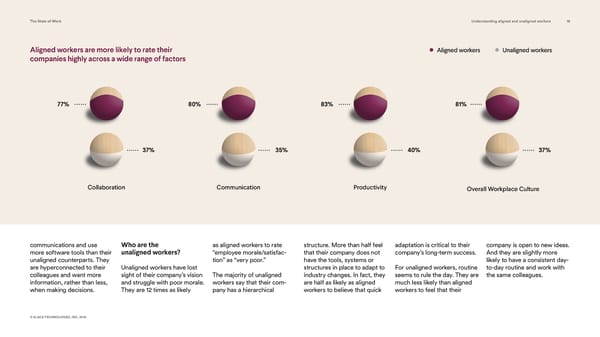
The State of Work 19 CHAPTER 3 Alignment affects the bottom line: here’s why © SLACK TECHNOLOGIES, INC. 2019
The State of Work Alignment affects the bottom line 20 here are clear Aligned workers to wow customers or pilot new benefits to invest- are nearly twice as marketing strategies that help Ting time, effort and 34% likely as unaligned sales teams close deals faster. resources into building an workers to predict aligned workforce—namely, significant growth In contrast, unaligned work- aligned workers drive ers are far likelier than business forward. aligned workers to forecast Significant workforce growth “significant decline” in their They approach their com- company’s financial future. pany’s future with optimistic 24% Moreover, unaligned work- purpose and are nearly twice ers are seven times as likely as likely as unaligned work- 14% to report that they do not feel ers to believe that teams at empowered to make strategic their company are work- business decisions or pursue ing toward a shared vision. Significant revenue growth new business opportunities. They are also nearly twice as Aligned workers likely as unaligned workers to are more likely to 30% expect “significant growth” feel that teams are UNALIGNED WORKERS: in their company’s revenue moving in the same 16% WHAT’S AT STAKE and workforce. direction What’s more, they’re willing 60% to act on that optimism. 12x Three-quarters of aligned BELIEVE TEAMS AT THEIR workers feel empowered COMPANY ARE WORKING Unaligned workers to make strategic business TOWARD A SHARED VISION are 12 times as likely decisions or pursue new as aligned workers business opportunities. That Aligned workers to rate “employee mindset enables them to morale/satisfaction” propose new product features Unaligned workers as “very poor.” © SLACK TECHNOLOGIES, INC. 2019
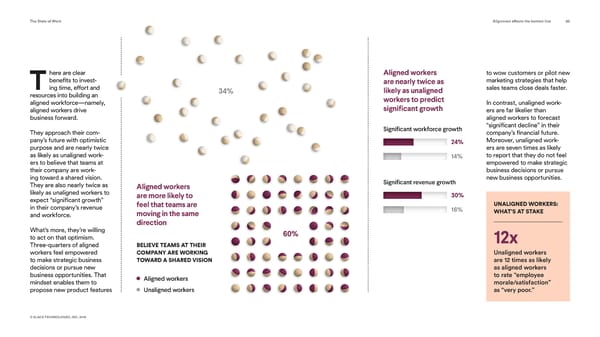
The State of Work Alignment affects the bottom line 21 Critically, aligned workers are focused on high-impact, strategic work, such as com- ioral and social determinants and make real-time deci- petitive intelligence, effective of health. Care Teams use sions. “If we don’t have use of technology, and inno- Cityblock’s care delivery that same mindset—of the vation. Unaligned workers are platform, Commons—which members being at the center bogged down by staffing and was co-designed by clini- of everything we do—and personnel challenges. They are cians, engineers and data if all of our activities don’t twice as likely as aligned work- scientists—to align around have that same purpose and ers to cite poor management each member. Co-founder why,” she says, “then all of decisions as a challenge. and CEO Iyah Romm says the work that we’re doing alignment is essential in runs the risk of being ALIGNMENT IN ACTION uniting cross-functional disjointed or fragmented.” teams to deliver the best Cityblock Health, a Brook- possible care. “Without Clarity of mission has Aligning around lyn, New York–based, tech- aligned priorities and ways enabled Cityblock to rede- 75% nology-driven health-care of working, we’ll never get fine health care for thou- of aligned workers feel company, is reimagining anything done in a complex sands of members across empowered to make a “North Star” an industry long known for ecosystem,” he says. the communities it serves. strategic business resistance to change. The And for Romm, this is just decisions or pursue new to transform company is committed to For Theresa Soriano, City- the beginning of bringing business opportunities. offering member-first, tech- block’s northeast regional better care to neighborhoods nology-enabled care to chief health officer, setting a where it’s needed most. health care in improve health outcomes in North Star to guide all “You ultimately end up underserved communities. decisions and actions was building for your goals … 22% underserved key. It empowers everyone and so setting goals that At Cityblock, integrated, from Community Health force you to think in different of unaligned workers multidisciplinary care teams Partners in the field to soft- ways than the status quo is, feel the same way. communities work collaboratively to ware developers in the office I think, a requirement for address the medical, behav- to recommend improvements driving meaningful change.” © SLACK TECHNOLOGIES, INC. 2019
The State of Work 22 CHAPTER 4 Getting to alignment © SLACK TECHNOLOGIES, INC. 2019
The State of Work Getting to alignment 2323 How to achieve Knowledge workers who Aligned workers alignment communicate hourly want connection and with colleagues are most communication with There is no simple solution, likely to feel aligned colleagues but there are strategies that can enable an aligned work- There is a direct correlation force. Top among them: between alignment and how communication. 63% frequently knowledge workers 58% communicate with their col- Aligned workers crave com- leagues. The more often they munication—around strategic connect with coworkers, the goals, with their colleagues 50% likelier they are to feel aligned, and from leadership. 45% whether that communication happens through collaboration 41% % Although they are the most a o tools, emails, phone calls or l f likely to have their company’s i n other means. The inverse also g o strategic goals communicated n n applies: Alignment drops as ed - on a monthly basis (the most w m the frequency of communica- a frequent option available on o n tion decreases. r a the survey), aligned workers k g clearly indicated that they ersem This is especially true for wanted more communica- en non-management workers. t tion, not less. But the quality Those who communicate of that communication mat- with other employees at least ters as much as, if not more Less than Once 2–3 times Several times Hourly hourly are the most likely to than, the frequency. once per day per day per day per day feel aligned (63%), while those who communicate with col- leagues less than once per day are the least likely to feel frequency of communication aligned (41%). with colleagues © SLACK TECHNOLOGIES, INC. 2019
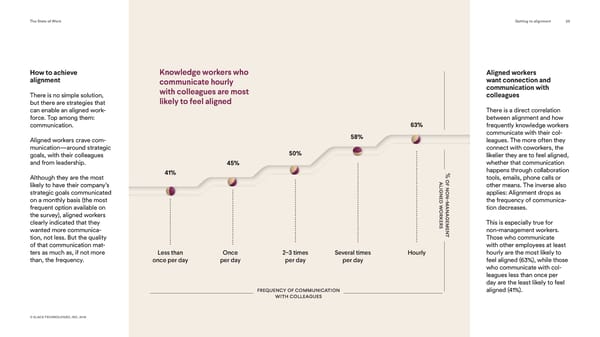
The State of Work Getting to alignment 2424 Three or four meetings 80% per day is the alignment sweet spot More meetings improve 76% alignment—to a point 75% Meetings have weathered a Management reputational blow in recent Non-Management years, but the value of in-per- son (or on-camera) syncs 68% prevails. Aligned workers have more meetings than unaligned 65% 66% workers across the board— in comparison, unaligned workers are twice as likely as 62% aligned workers to have no daily meetings. % o f a l Logic would suggest that i g more meetings lead to more n e alignment. But filling workers’ d w calendars isn’t necessarily the o r answer. The sweet spot seems k e to fall at three or four meetings r per day. After four meetings, s alignment dips for non-manag- 49% ers and managers alike. 0 meetings 1–2 meetings 3–4 meetings 5+ meetings per day per day per day per day typical number of meetings per day © SLACK TECHNOLOGIES, INC. 2019
The State of Work Getting to alignment 25 Share strategy goals Aligned workers are Monthly from sharing its strategy annu- UNDERSTANDING OF STRATEGIC quarterly at minimum the most likely to 47% ally to monthly to reap the GOALS IN RELATION TO FREQUENCY receive monthly 29% benefits. Even incremental OF COMMUNICATION Communicating with col- communication about increases in communication leagues may be a key element their company’s goals frequency can improve knowl- of alignment, but ensuring that Quarterly edge workers’ understanding knowledge workers under- 30% of company strategy. stand the company’s strategic 76% 71% goals is equally, if not more, HOW FREQUENTLY A 24% For instance, a subtle shift important. To understand the COMPANY COMMUNICATES from communicating strategic strategy, knowledge workers ITS STRATEGIC GOALS Twice a year goals annually to twice a year Monthly Quarterly need to know what it is. That 5% boosts understanding of the knowledge comes through fre- company strategy by 9 per- quent communication. 5% centage points. Aligned workers More than three-quarters of Unaligned workers And there are other benefits aligned workers (77%) report Yearly to communicating strategy 68% 59% that their company commu- 11% monthly: Workers who receive nicates its strategic goals 16% monthly strategy updates at least quarterly. Nearly are the most likely to say that half (47%) say their compa- their company is open to Twice a year Yearly ny’s goals are shared at least Every 2–3 years new ideas. The same can be monthly. Unaligned workers, 3% said about employees who on the other hand, are the 7% feel that teams at their orga- most likely to report that their nization are working toward company never shares its a shared vision. 59% 46% strategic goals. Never 5% There’s also a direct cor- The good news is that a com- relation between monthly pany doesn’t need to jump 18% communication of strategy Every 2–3 years Never © SLACK TECHNOLOGIES, INC. 2019
The State of Work Getting to alignment 26 and workers rating a com- direct managers are the ones leaders have to think carefully PERCENTAGE OF ALIGNED Team meetings offer this to pany as “excellent” for career sharing strategic objectives. about both their messaging and WORKERS WHO UNDERSTAND a degree, and, accordingly, progression, collaboration, the mediums used to convey it. THE COMPANY STRATEGY knowledge workers rank communication, effective use But while tapping the CEO to them as the most effective of technology, productivity, communicate corporate goals forum for communicating morale, training, work-life bal- can be a smart choice, there Meetings and strategic goals. But for deep- ance, culture and openness is a caveat: the leaky bucket collaborative channels Executive ening understanding and to feedback. of executive communica- are most effective 90% Management encouraging discussion of tions, when messaging gets strategic goals, collaboration diluted as it moves down the Teamwide meetings win out tools are key. The leaky bucket of organizational ladder. Even as the most popular form for executive communications aligned workers aren’t immune strategic communications, Senior Eighty-one percent of knowl- to this effect. followed by email announce- 90% Management edge workers at companies Companies must also decide ments and companywide using collaboration tools to who will communicate stra- Unsurprisingly, most aligned meetings. This ranking communicate their strate- tegic goals. The obvious executives feel that they have applied across all knowledge gic goals indicate that they choice is the CEO or exec- a clear understanding of their workers surveyed. understand their company’s utive team. When aiming to company strategy. But that Management strategy. In fact, for under- ensure that knowledge work- understanding drops 13 per- But when it comes to strat- 89% standing company strategy, ers understand company centage points as one moves egy, hearing doesn’t always collaboration tools emerge as strategy, these are indeed down the organizational chart equate with understanding. the best medium, followed by good spokespeople. to general staff. For that, collaborative chan- videos and companywide and nels are key. To gain deeper Supervisor/ teamwide meetings. Three-quarters of knowledge This dilution of strategy com- insight into their company’s 86% Administrator workers who receive strat- munications applies across strategy, knowledge workers The upshot? Encourage lead- egy communications from the the board, to both aligned and seek a “two-way street” that ership to share strategic goals CEO feel they understand the unaligned workers, although facilitates an inclusive, organic on a monthly basis and to do company strategy. This drops aligned workers start at a dialogue between and among so through meetings and col- slightly to 74% for the exec- higher level of understanding. executives, managers and General laboration tools. utive team and to 68% when To combat information loss, office personnel. 77% Staff © SLACK TECHNOLOGIES, INC. 2019
TThhe Se Sttaatte oe of Wf Woorrk bk y Slack Getting to alignment 2277 Knowledge workers are more likely to understand their company’s strategy if it is communicated via collaboration tools 81% 75% 75% 76% 77% 77% 77% u n 63% d e k r n s t o an w d l c ed o g mp e an w o y r s k t ers r w a t h e g o y ( % Other Email Company Company Teamwide Companywide Videos Collaboration ) announcements intranet blog meetings meetings tools medium used to communicate strategic goals ©© S SLLAACCK TK TECECHNHONLOOGLIESOG, INIECS, I. 2N01C9. 2019
The State of Work 28 CHAPTER 5 The alignment paradox © SLACK TECHNOLOGIES, INC. 2019
The State of Work The alignment paradox 29 he benefits of an aligned workforce Aligned workers are 81% 73% Tare readily apparent. of aligned workers expect the number of Companies want and need using more apps than report using more apps they need to use workers who are connected, apps than they did to increase further collaborative and optimis- five years ago tic about their company’s ever before future. But in today’s fast- paced, high-pressure world of work, the immediate impulse is often to double down on alignment by scheduling more meetings, introducing more tools and encouraging more Most aligned workers 30 min. 130 hrs. communication. 64% report spending Over the course of The catch is that aligned lose 130 hours each 30 minutes or more an average working workers are already inun- switching between year (260 days), this dated. Aligned employees are year switching apps each day amounts to 130 hours the most likely to have 10 or of lost productive time more meetings a day and the most likely to send or receive between apps hourly emails, messages and 51% phone calls. Additionally, 64% of aligned workers report that switching report spending 30 minutes between apps “makes or more switching between it harder for me to get apps each day. essential work done” © SLACK TECHNOLOGIES, INC. 2019
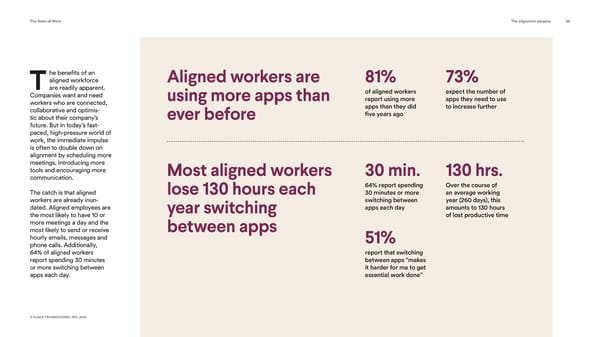
The State of Work The alignment paradox 30 “The cost of choice and That half hour of lost pro- App usage is on interdependent tasks to the information overload is that ductivity takes on staggering the rise globally forefront of knowledge work- proportions when looked at ers’ daily routines. This shift people get distracted, people across an entire company. An requires knowledge workers enterprise with 2,500 employ- 76% to engage more with tech- are making more errors because ees working 260 days a year of all knowledge nology as they connect with could lose 325,000 hours of workers surveyed report colleagues to tackle complex productivity annually. using more apps than projects across teams and they’re multitasking, and if they did five years ago time zones. And things aren’t slowing down. Eighty-one percent you’re not giving yourself the of aligned employees report Communication using more apps than they 68% can become did five years ago, and 73% expect that all-consuming time to focus, you are less expect the number of apps number to rise they need to use to increase As the complexity of work good at engaging in creative further. There’s an urgent increases, so does the need need for management to pro- groups and industries report for cross-functional team- vide clear direction and limits using more apps than ever work. And communication problem-solving.” so aligned workers can use before. Seventy-six percent of between teams is hard—and their time more effectively. all respondents reported using even harder for those working more apps than they did five on teams distributed across years ago, and 68% expect multiple offices, time zones Knowledge workers that number to rise. and countries. worldwide are under pressure This makes sense in light of More than half (52%) of current workplace trends, in knowledge workers who Sheena Iyengar, This paradox isn’t limited to which automation is increas- communicate with col- S.T. Lee Professor of aligned workers. Knowledge ingly displacing rote work leagues in several time Business, Columbia workers across all regions, age and pushing more complex, zones find cross-functional Business School © SLACK TECHNOLOGIES, INC. 2019
The State of Work The alignment paradox 3131 TOP MANAGEMENT AND communication challeng- CULTURE CHALLENGES ALIGNMENT IN ACTION ing. The same can be said of GLOBALLY those who work with different people and teams every day— Canada’s largest 63% of them feel the strain. Martin Wildberger, Collaborating with bank leverages Executive Vice people across President, Innovation Knowledge workers need 1 several time zones and Technology, RBC better (not more) software new tech tools Adding more software and to reinvent itself communication tools isn’t the Using more than answer—workers need better six apps per day When used well, technology solutions. Knowledge work- 2 is a key driver of innovation ers often find their attention divided across multiple ave- nues, and the proliferation of workplace software that Receiving more Reinvention is not just the transforming itself into data, which we are able to (mostly) enhances productivity than 25 emails daily domain of startups. Disruption a digital-first institution, connect and analyze through can also contribute to frag- 3 in this new era of work is according to the company’s new techniques like AI,” mentation of attention. something even the largest executive vice president of Wildberger says. “As a result, and most successful enter- innovation and technology, we will soon only be limited by More than half of knowledge prises are tackling head-on. Martin Wildberger. our own imaginations. These workers who use more than Working with And leaning into new technol- advancements are allowing us six apps on a daily basis find different people and ogies is a major part of that “One of the most exciting to not only derive better solu- cross-functional communica- 4teams every day* transformation. things on the innovation front tions to problems we’ve been tion challenging. The same is we’re approaching an age wrestling with for ages, but applies to those who receive The Royal Bank of Canada, where we have access to tre- more importantly to do things more than 25 daily emails. *For each condition, more than half of respondents found a 150-year-old bank and mendous compute capacity that we’ve never done before.” it challenging to “communicate with coworkers in different teams, departments or offices.” the largest in Canada, is alongside an abundance of © SLACK TECHNOLOGIES, INC. 2019
The State of Work The alignment paradox 32 Beyond communication, the But these innovators seem Be choosy about choosing very technology that should to have landed on a solution. Leveraging the boost productivity can under- They are the most likely to feel Determine which decisions mine it. Nearly half of all that collaboration tools are an power of choice 1 you can delegate to others or knowledge workers surveyed effective form of communi- technology. (49%) reported that switch- cation, at almost three times ing between apps prevents the rate of employees at lag- in the workplace them from getting essential gard companies (those that are work done. among the last to adopt new Identify your priorities products and services). From the innovator stand- The average working person in a Select three to five significant The innovator’s dilemma point, it’s clear that apps aren’t 2 problems or ideas to focus on. going anywhere. So the best, developed country deals with an The app overload effect is most effective approach is to extraordinary amount of information particularly profound at “inno- consolidate them in a collab- vator” companies—those that oration platform to stem the each day—the equivalent of reading Keep your end goal in mind adopt new products and ser- fragmentation of attention. 174 newspapers, according to vices first. Almost all workers True to form, the innovators Rather than reacting to at innovator companies report may have found and adopted Columbia Business School professor 3 incoming information, define using more apps than they did a solution that will inform the Sheena Iyengar. Here, she shares what you need to know to five years ago. future of work. strategies for dealing with too move forward. And as with aligned workers many decisions. overall, app switching can get in the way of actual work. Set limits Eighty-one percent of work- ers at innovator companies Put a time cap on information- report spending at least 30 4gathering and set an endpoint minutes each day switching for making a decision. between apps. © SLACK TECHNOLOGIES, INC. 2019
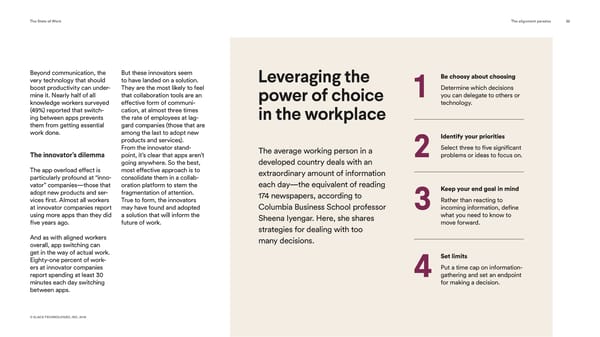
The State of Work 33 CHAPTER 6 Looking ahead: the 8 rules of engagement © SLACK TECHNOLOGIES, INC. 2019
The State of Work Looking ahead 3344 ortunately, alignment is The Invest in strategy are more likely to company as open to not a finite resource. It’s alignment now rate their company positively new ideas and believe that Fa competitive advantage 1 across a wide range of met- teams are working toward available to every worker and Engagement The majority of knowl- rics, including collaboration, a shared vision. every company, everywhere. edge workers want to feel employee morale and work- Eight more aligned. And leaders place culture. By setting a Allow people What people want—and who prioritize that stand to North Star for workers to fol- to be more need—is to feel part of the gain clear benefits: Aligned low, leaders empower their 4human at work bigger plan. To be kept in the workers are more collabora- teams to make decisions, and loop. To have the support and 8 tive, innovative, empowered act and innovate in the best While organizational alignment understanding they need to and filled with optimistic pur- interest of the business. can help workers connect with achieve their best work. Even pose about their company’s their colleagues and compa- aligned workers agree that future. An aligned workforce Communicate ny, Susan David, a Harvard they want more alignment. Data is wonderful, but how nets out positively for both your strategy Medical School psychologist And workers everywhere can you translate that into workers and the companies 3monthly and the author of Emotional want more transparency, fre- that support them. Agility, emphasizes the impor- quent communication and a action within your team or A bold vision and detailed tance of individual alignment. clear understanding of who’s your company? Here are the Lead with strategic plan aren’t effective That is, when employees feel doing what. strategy if they’re not known. When a sense of clarity and connec- Engagement Eight, or eight 2and vision it comes to communicating tion between their values and Companies acting now, with principles we feel all leaders, strategy, monthly is the ideal day-to-day work. That clarity people in mind, can reshape Without insight into their cadence, but even incremental of purpose can ladder up to their trajectories toward from executives to managers, company’s strategic vision, increases in frequency organization-wide benefits. more innovation, happier can leverage to provide people struggle. Unaligned can improve workers’ “When people are allowed and more engaged work- workers are the most likely to understanding. Beyond to bring their emotional truth ers, and ultimately more their teams with the support have never heard their com- alignment, there are other to work,” David says, “that growth and revenue. needed to achieve the best pany discuss strategic goals. benefits to communicating is when innovation, creativi- Conversely, workers who strategy monthly: Workers ty, engagement and culture possible outcomes. understand their company’s are more likely to see their thrive in the organization.” © SLACK TECHNOLOGIES, INC. 2019

The State of Work Looking ahead 35 “When people are allowed Empower all Knowledge workers seek a fragment attention. leaders to share “two-way street” that facil- Nearly half of knowledge 5the strategic itates an inclusive, organic workers today report that to bring their emotional vision, but start dialogue between and among switching between apps at the top executives, managers and prevents them from getting office personnel. Team meet- essential work done. So select truth to work, that is when Knowledge workers want to ings offer this to a degree, apps carefully and source hear from the source. When and, accordingly, knowledge solutions that consolidate, innovation, creativity, plans are passed down, infor- workers rank them as the most rather than divide, attention. mation gets lost along the effective forum for commu- way. Workers are most likely nicating strategic goals. But Distraction isn’t engagement and culture to understand the company for deepening understanding just a productivity strategy when they hear it and encouraging discussion 8killer from leaders, whether CEOs around strategic goals, collab- thrive in the organization.” or other executives. Three- oration tools emerge as the Distraction also means you quarters of knowledge most effective medium. leave behind your best pos- workers who receive strat- sible problem-solving brain. Susan David, egy communications from the Aggregate tools “If you’re not giving your- Harvard Medical CEO feel they understand the and information self the time to focus, you School psychologist company strategy. This drops 7 are less good at engaging and author of slightly, to 74%, for the exec- The software prolif- in creative problem-solv- Emotional Agility utive team and to 68% when eration trend is here to stay. ing,” says Columbia Business direct managers are the ones Globally, knowledge workers School professor Sheena sharing strategic objectives. are using more apps than ever Iyengar. And perhaps even before. And while apps can (and more seriously, it’s long been Opt for meetings do) help people become more proven that distraction leads and collaborative productive and collaborative, all to errors, which, depending 6channels when of this “context switching” can on your industry, could have sharing strategy have the opposite effect and steep costs. © SLACK TECHNOLOGIES, INC. 2019
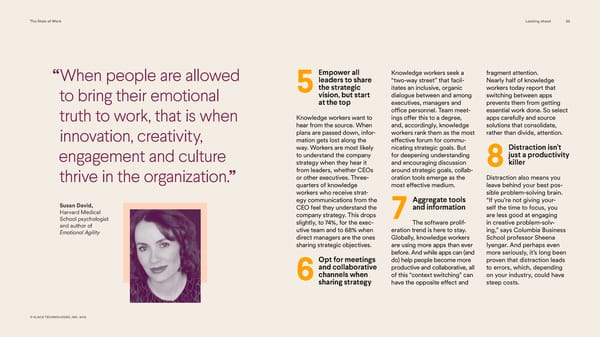
The State of Work 36 CHAPTER 7 Methodology © SLACK TECHNOLOGIES, INC. 2019
The State of Work Methodology 37 In the first quarter of 2019, SAMPLE SIZES IN EACH MARKET (someone who uses the the highest-quality and most screen for contradictory Slack partnered with market internet from any device and representative data, the sur- answers. Between 5% and research firm GlobalWebIndex any location) and knowledge vey was broken into several 10% of the surveys in each to undertake multimarket, Australia 1,250 workers (employed individuals themed “blocks,” which were market were removed during quantitative research designed who hold an office position then randomized to remove these checks. to understand the views of Brazil 1,000 and/or “work with data, any bias around the ques- knowledge workers as well as France 1,250 analyze information or think tion order. Routing methods, Within the final sample, the trends affecting the future creatively” in a typical work which direct respondents to respondents were assigned of the workplace. Germany 1,250 week). The surveyed popu- relevant survey questions, a weight based on their lation spanned an age range were applied to ensure that all representativeness of Slack and GlobalWebIndex India 2,000 of 16 to 64, more than 40 respondents were presented surveyed markets. Weights co-designed the questionnaire, industries, all company sizes, with questions pertaining to took into account age, gender which GlobalWebIndex then Japan 1,000 and all career levels (from their workplace experience. and education profile and fielded as an online survey skilled/semi-skilled work- were used to estimate how to 17,000 knowledge work- Singapore 1,000 ers and office staff to senior After fieldwork was com- many real-world people a ers across 10 markets. The executives). pleted, GlobalWebIndex data point represents. The 20-minute survey included Spain 1,250 vetted all responses across a report specifies when these Likert scale, dichotomous and Participants completed the series of metrics. These projections were used. multiple-choice questions. U.K. 3,000 survey in their local lan- included analysis of survey guage, and questions were completion time; checks for All respondents were iden- U.S. 4,000 localized to each country to patterned answers; and the tified as internet users ensure relevancy. To produce use of logic traps, which © SLACK TECHNOLOGIES, INC. 2019
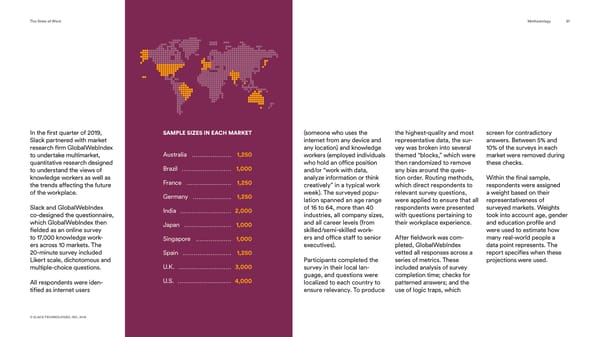
The State of Work 38 The State of Work, by Slack © SLACK TECHNOLOGIES, INC. 2019 © SLACK TECHNOLOGIES, INC. 2019
